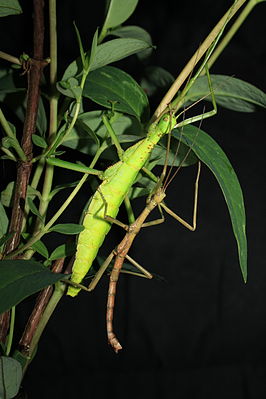Rhaphiderus spinigerus
| Rhaphiderus spinigerus | ||||||||||||
|---|---|---|---|---|---|---|---|---|---|---|---|---|

Rhaphiderus spinigerus , pair |
||||||||||||
| Systematics | ||||||||||||
|
||||||||||||
| Scientific name | ||||||||||||
| Rhaphiderus spinigerus | ||||||||||||
| ( Lucas , 1862) |
Rhaphiderus spinigerus (sometimes Rhaphiderus spiniger is called) a species in the order of the stick insects (Phasmatodea). Occasionally it is also referred to as the Réunion ghost insect based on its originor, less appropriately, the rhododendron insect after a possible forage plant.
features
Rhaphiderus spinigerus is a medium-sized ghost insect with pronounced sexual dimorphism . The females are about 5.5 to 7.5 cm long and are much wider and thicker than the males. On the upper side of the body they are bright light green, on the underside they are colored pale dark green. There are irregularly distributed, blunt thorns or tubercles on the pro- and mesonotum . These are colored brown to light orange at the tip and yellow towards the base. The edges of the meso- and metathorax are serrated with similarly colored thorns. The rear coxes are conspicuously pink to red. The males remain somewhat smaller with 4.5 to 6.5 cm in length and are much slimmer. They are glossy light brown in color. Only the intersegmental membranes of the abdomen are greenish. There are a few dark brown thorns on the pro and anterior mesonotum. In addition to animals with the coloration described, orange, reddish or brown females and green males can also occur.
Occurrence and way of life
The species is native to the island of Réunion in the Indian Ocean and can be found there at altitudes between 250 and 500 m.
The animals spend their entire life hanging on the food plants. Adult females produce eggs in abundance. These are brown, about 2 to 2.5 mm wide, 3 to 3.5 mm long and have a heart-shaped micropylar plate. On the lid (operculum) there is a clearly visible, yellowish capitulum (see also construction of the phasmid egg ). After four to five months, the nymphs hatch from the eggs, which are dropped on the ground by the females , which are adult after three to four months and then live for about four months or longer, depending on the temperature.
Taxonomy and systematics
In 1862 Hippolyte Lucas first described this species under the name Monandroptera spinigera . In 1904, William Forsell Kirby assigned them to the genus Rhaphiderus, which was established by Jean-Guillaume Audinet-Serville in 1838 . There is disagreement about the correct ending of the specific epithet . In 2004 Nicolas Cliquennois and Paul D. Brock still use the name Rhaphiderus spinigerus . This name is used in many publications and lists to this day. Cliquennois revised the name in 2005 and called the species Rhaphiderus spiniger . This name can also be found in many publications to this day.
Terrariums
The first animals of this species came to Europe in 1979 through Jean-Claude Anderes from Bel Air, Plaine des Gregues. Other animals were collected by Cliquennois at various sites between 2001 and 2003. Initially, these animals were identified as Rhaphiderus scabrosus and were given PSG number 82 by the Phasmid Study Group. When a slightly larger species was introduced from the island of Mauritius in 1984 , the males of which are glossy dark green in color and have yellow intersegmental membranes on the abdomen and conspicuously red eyes , these were also wrongly identified as Rhaphiderus spinigerus and they were given the PSG number 83. It was not until 2003 that Brock clarified that the two species were interchanged, so that the animals that were imported first were listed under PSG number 82 in circulation were Rhaphiderus spinigerus , while the later imported species with PSG number 83 is Rhaphiderus scabrosus . All publications about the keeping of these animals were consequently made with mixed up names until 2003.
Well-ventilated terrariums with the highest possible humidity are required for keeping and breeding . Leaves of rhododendrons or St. John's herbs are suitable as feed . Eucalyptus leaves are also eaten.
Individual evidence
- ↑ a b c d e Alexander Esch: Poles, ghosts, walking leaves: successful keeping of phasmids . Natur und Tier-Verlag, Münster 2012, pp. 109–110, ISBN 978-3-86659-221-6
- ↑ a b c d e Rhaphiderus spinigerus species profile (Lucas, 1862) PSG No. 82 . Arthropoda Popularis, 3 (1) 2013, ZAG Wirbellose eV, Dessau-Roßlau 2013, pp. 13–15, ISSN 1866-5896
- ↑ a b c Phasmatodea page by Oskar V. Conle and Frank H. Hennemann
- ↑ a b c Allan JE Harman: The development of the Phasmid Species List (Part two) , Phasma Werkgroep, No. 82 September 2011, Volume 21, p. 14, ISSN 1381-3420
- ↑ Christoph Seiler, Sven Bradler & Rainer Koch: Phasmids - Care and breeding of ghosts, stick insects and walking leaves in the terrarium . bede, Ruhmannsfelden 2000, pp. 119–120 ISBN 3-933646-89-8
- ↑ Nicolas Cliquennois and Paul D. Brock : Bulletin de la Société entomologique de France 109 (1) , 2004, p. 54
- ↑ a b Phasmid Study Group Culture List (Eng.)
- ↑ Nicolas Cliquennois: PSG Newsletter 102: 4 , 2005
- ^ A b Paul D. Brock: Phasmida Species File Online . Version 5.0 / 5.0 (accessed March 7, 2014)
